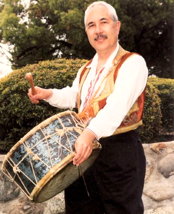
|
Folk Dance Federation of California, South, Inc.
|

|
CLICK AN IMAGE TO ENLARGE
Zagorisios, pronounced "zah-gor-EE-see-ohs," translates as "from Zagori," which is a very mountainous region of the northwest Greek province of Epirus, approximately 40 kilometers north of Yannina, the capital, and split by a Grand Canyon-sized gorge.
The meter of the dance is 5/4 and the tempo is andante, or a metronome quarter note time = 108. The rhythm is quick-quick-quick-slow (Q-Q-Q-S or 1-1-1-2 = 5).
Zagorisios is danced in a large open circle using the typical Greek hand hold with the arms bent up at the elbow ("W" position).
Accompaniment is usually by clarinet, violin, giitar, or lauto, and large tamborine.
The dance I learned has a pattern, or figure, of 4 measures in length for 20 counts. With the notable exception of the first two movements, it is the same as that danced by folk dancers in Southern California, with the first measure danced in place, the second moving sidewise right, the third in place, and the fourth sideways left. In Epirote dances, and particularly in Zagori, the hips always stay within the plane or orientation of the body, that is, to dance is to "look like a belly dancer."
Styling is flat-footed, deliberate, generally smooth or flowing, and low to the ground, except for periodic high-knee lifts and the leader's variations. The leader must improvise within the dance pattern, is limited only by his or her creativity, and should let another dancer lead after five minutes or so.
I observed, learned, and danced Zagorisios during all three of my trips to Greece. I have taken additional information from "Ellinikoikai Evropaikoi Horoi," 1960, by G. Kousiados, and from "Ellinikoi Horoi," 1960, by V. Papachristos.
Along with "Syrto Kofto," the standard "Kalamatianos," and the northern version of "Tsamikos," Zagorisios is danced at all Epirote weddings, parties, saints' days, and special celebrations.
Music Definitions
Meter: The grouping in which a succession of rhythmic pulses or beats is organized into regular patterns in time, notated as measures, and indicated by a meter signature at the beginning of a work. For example, 5/4.
Rhythm: The controlled movement of sounds and silences across time; the temporal quality of sound. For example, quick-quick-quick-slow (Q-Q-Q-S or 1-1-1-2 = 5).
Used with permission of the author.
Reprinted from Folk Dance Scene, December, 1990, Page 13.